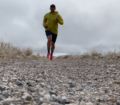Colorado. I love this place. In 2008, I was fortunate to move here and bring my love of endurance sports with me. Life is different in Colorado. Who you are is what you do. Climber? Skier? Mountain biker? Ultrarunner? It’s not about what you have…it’s what you do. How do you live your life? What do you do with your precious time?

Ultrarunners stop at sunrise on Mt. Evans
I don’t take it for granted when I stop on the trail to let a deer, bear, or moose walk by. I just acknowledge them and say hello. Sometimes It’s just me out there alone for hours. It’s like I’m running through an Ansel Adams photo. I’m invigorated by the power and beauty of the mountains. Nature is everywhere in Colorado, though.
At home, baby rabbits nibble on my grass. A turtle wanders through the neighborhood after getting lost on his way back to the pond. I stop to let deer or baby ducks cross the road. A bald eagle sits atop a tall tree on a trail near my house. I named him “Maverick” for no real reason other than to be able to say “hi Maverick” when I run by.
When the time comes, I head up to the mountains. From a trailhead, we run and hike through the forest. Soon, we are above the tree line where very little plantlife grows. Marmots pop out and say, “Hi”. Time seems to slow down up there…I feel very small and fully alive at the same time. When the run is done, we return to our cars and hug and high-five. What a day! Often, I can’t sleep the night after a full day of mountain running in Colorado. I just keep reliving those moments over and over in my head. Is this place for real?
Past experience in organized ultrarunning events helped prepare me for the true adventure of mountain running here in Colorado. No, there aren’t any aid stations, but a few added pieces of gear like a water filter, larger pack, trekking poles, and SPOT tracker have allowed me to feel comfortable taking the long run above the tree line. Last year, I started working toward summiting all of the Fourteeners (14ers) here in Colorado. With each summit, I do a quick headstand and grab a photo. My basement wall hosts the ongoing “Summit Headstand Project” that is slowly coming together.

Redcloud Peak summit headstand
There are more than 54 mountains in Colorado with a summit at an altitude above 14,000ft. Although there is some back and forth about what actually constitutes a “14er”, most agree on a known set of 58 peaks. In addition to these 14ers, Colorado has over 700 peaks with a summit above 13,000’. There are countless ways to carve up very long adventure runs from the trailheads to the summits and in between. This is what gets my heart racing these days.

During an adventure run of Mt. Evans to Mt. Bierstadt to Grays and Torreys.
The 14ers are scattered throughout Colorado. Some of the peaks are more technical than others, but any of them can be very dangerous to the unprepared. (Being humble has always been a good thing in ultra…it’s even more important when you are going long at high elevation.) There is a difficulty ranking system used in mountaineering, which identifies a climbing route from “Class 1” to “Class 5”. Because there are various routes to the summit of these peaks, you could feasibly climb the same mountain in several different ways.
From 14ers.com:
Class 1: Easy Hiking- Usually on a Good Trail
Class 2: More difficult hiking that may be off-trail. You may also have to put your hands down occasionally to keep your balance. May include easy snow climbs or hiking on talus/scree.
Class 3: Scrambling or un-roped climbing. You must use your hands most of the time to hold the terrain or find your route. This may be caused by a combination of steepness and extreme terrain (large rocks or steep snow). Some Class 3 routes are better done with rope.
Class 4: Climbing. Rope is often used on Class 4 routes because falls can be fatal. The terrain is often steep and dangerous. Some routes can be done without rope because the terrain is stable.
Class 5: Technical climbing. The climbing involves the use of rope and belaying. Rock climbing is Class 5.
As ultrarunners, we commonly fixate on the distances of an adventure run. Taking those same long runs high into the mountains means an increased need for planning and good judgment. For instance, you have to know when to turn back as dark clouds and lightning approach, even if you are 300ft from the summit. It may mean the difference between life and death.
Having a partner or small team of fellow endurance athletes can help keep you safe. We commonly share food, water, or equipment when we go off the grid for a long adventure run. Having someone you can trust is a necessity in this environment. Last year, a runner in our team fell and injured her elbow. We stopped and fashioned a sling for her arm, then all took a piece of her gear so she could continue without carrying any weight.
Experience in ultramarathon is a good base for the extreme mountain run but experience in the high-altitude terrain is also a must. In addition to all the challenges of an ultra, like dehydration, bonking, blisters, or fall injuries…taking those runs into the alpine mean increased risk from rapidly changing weather, deadly cliffs, falling rocks, exposure, etc.
My personal challenge in the high country is anxiety of heights. My close friends (and now all of you) know that I get a little freaked out when the top of a mountain feels like the top of a building. I have often relied on the patience of my running/climbing partners while I try to calm my breathing in those last few hundred feet. When I finally boulder over those last few feet to the summit, my heart races and adrenaline surges through my veins. That feeling is unlike anything in the world. Overcoming fear, whether it is of the unknown, anxiety, or otherwise, is something that makes you feel truly alive. After all, without the possibility of failure would we take on these challenges?
There are countless resources for those who want to take on the 14ers. An excellent resource is www.14ers.com. This site lists the various peaks with current condition reports from other climbers. Because the conditions change so rapidly, it’s nice to have a trip report from someone who was there in the previous week. This site also lists the mountains in order of difficulty so one could start with the less risky climbs and then begin branching out as they become more comfortable. The prime time to summit these peaks is June-September because of the lack of snow (Unless you like the added challenge of winter climbing).
So yeah…come visit. Come to Colorado and summit a mountain.
Run long and prosper,
Jerry

























Hey I am out here for the summer in break and was going to try and run up some 13ers and 14ers, but I am curious what sort of gear you guys use. I have only hiked up fourtneers before.
I’m also interested in what you all were running with in terms of gear and nutrition. I’m looking at doing the DeCaLiBross loop (Democrat, Cameron, Lincoln, and Bross) this August. I currently have the Ultimate Direction AK 2.0 vest with the two 20 ounces bottles but I’m looking at the Scott Jurek vest for more storage space and the 70 ounce bladder to hold more fluids.